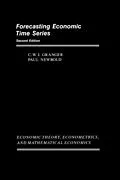Economic Theory, Econometrics, and Mathematical Economics, Second Edition: Forecasting Economic Time Series presents the developments in time series analysis and forecasting theory and practice. This book discusses the application of time series procedures in mainstream economic theory and econometric model building.
Organized into 10 chapters, this edition begins with an overview of the problem of dealing with time series possessing a deterministic seasonal component. This text then provides a description of time series in terms of models known as the time-domain approach. Other chapters consider an alternative approach, known as spectral or frequency-domain analysis, that often provides useful insights into the properties of a series. This book discusses as well a unified approach to the fitting of linear models to a given time series. The final chapter deals with the main advantage of having a Gaussian series wherein the optimal single series, least-squares forecast will be a linear forecast.
This book is a valuable resource for economists.
Inhalt
Preface to the Second Edition
Preface to the First Edition
Chapter One Introduction to the Theory of Time Series
1.1 Introducing Time Series
1.2 Covariances and Stationarity
1.3 Some Mathematical Tools
1.4 The Linear Cyclic Model
1.5 The Autoregressive Model
1.6 The Moving Average Model
1.7 The Mixed Autoregressive-Moving Average Model
1.8 Interpreting the Mixed Model
1.9 Filters
1.10 Deterministic Components
1.11 Wold's Decomposition
1.12 Nonstationary Processes
1.13 Integrated Processes
1.14 Models for Seasonal Time Series
Chapter Two Spectral Analysis
2.1 Introduction
2.2 Filters
2.3 The Spectrum of Some Common Models
2.4 Aliasing
2.5 The Cross Spectrum
2.6 Estimation of Spectral Functions
2.7 The Typical Spectral Shape and Its Interpretation
2.8 Seasonal Adjustment: An Application of the Cross Spectrum
2.9 Advanced Spectral Techniques
Chapter Three Building Linear Time Series Models
3.1 Model Building Philosophy
3.2 Identification
3.3 Initial Estimates for Coefficients
3.4 The Autocorrelation Function as a Characteristic of Process Behavior
3.5 Estimation
3.6 Diagnostic Checking
3.7 Model Building for Seasonal Time Series
3.8 Time Series Model Building-An Overview
Chapter Four The Theory of Forecasting
4.1 Some Basic Concepts
4.2 Generalized Cost Functions
4.3 Properties of Optimal, Single-Series Forecasts
4.4 Optimal Forecasts for Particular Models
4.5 A Frequency-Domain Approach
4.6 Expectations and Forecasts
4.7 Unbiased Forecasts
4.8 Invertibility
4.9 Types of Forecasts
Chapter Five Practical Methods for Univariate Time Series Forecasting
5.1 Introduction
5.2 Box-Jenkins Forecasting Methods
5.3 Exponential Smoothing Methods
5.4 Stepwise Autoregression
5.5 A Fully Automatic Forecasting Procedure Based on the Combination of Forecasts
5.6 Comparison of Univariate Forecasting Procedures
Chapter Six Forecasting from Regression Models
6.1 Introduction
6.2 Single Equation Models
6.3 Simultaneous Equation Models
6.4 Danger of Spurious Regressions in Econometric Models
Chapter Seven Multiple Series Modeling and Forecasting
7.1 Introduction
7.2 Theoretical Models for Multiple Time Series
7.3 Causality and Feedback
7.4 Co-Integrated Series and Error-Correction Models
7.5 Properties of Optimal Multiseries Forecasts
7.6 Forecasting Aggregates
7.7 Rational Expectations
Chapter Eight Building Multiple Time Series Forecasting Models
8.1 Introduction
8.2 Building Bivariate Models: Unidirectional Causality
8.3 Building Vector ARMA Models
8.4 Building Forecasting Models for Several Related Time Series
8.5 Testing for Causality
8.6 Testing for Co-Integration
Chapter Nine The Combination and Evaluation of Forecasts
9.1 Typical Suboptimality of Economic Forecasts
9.2 The Combination of Forecasts
9.3 The Evaluation of Forecasts
9.4 A Survey of the Performance of Macroeconomic Forecasts
9.5 Econometric Forecasting and Time Series Analysis
9.6 Leading Indicators
Chapter Ten Further Topics
10.1 State-Space Representation, the Kalman Filter
10.2 Time-Varying Parameter Models
10.3 Nonlinear Models
10.4 Bilinear Models
10.5 Instantaneous Data Transformations
10.6 Forecasting White Noise
10.7 Predicting Variances: ARCH Models
10.8 Forecasting Unobserved Components
References
Author Index
Subject Index
